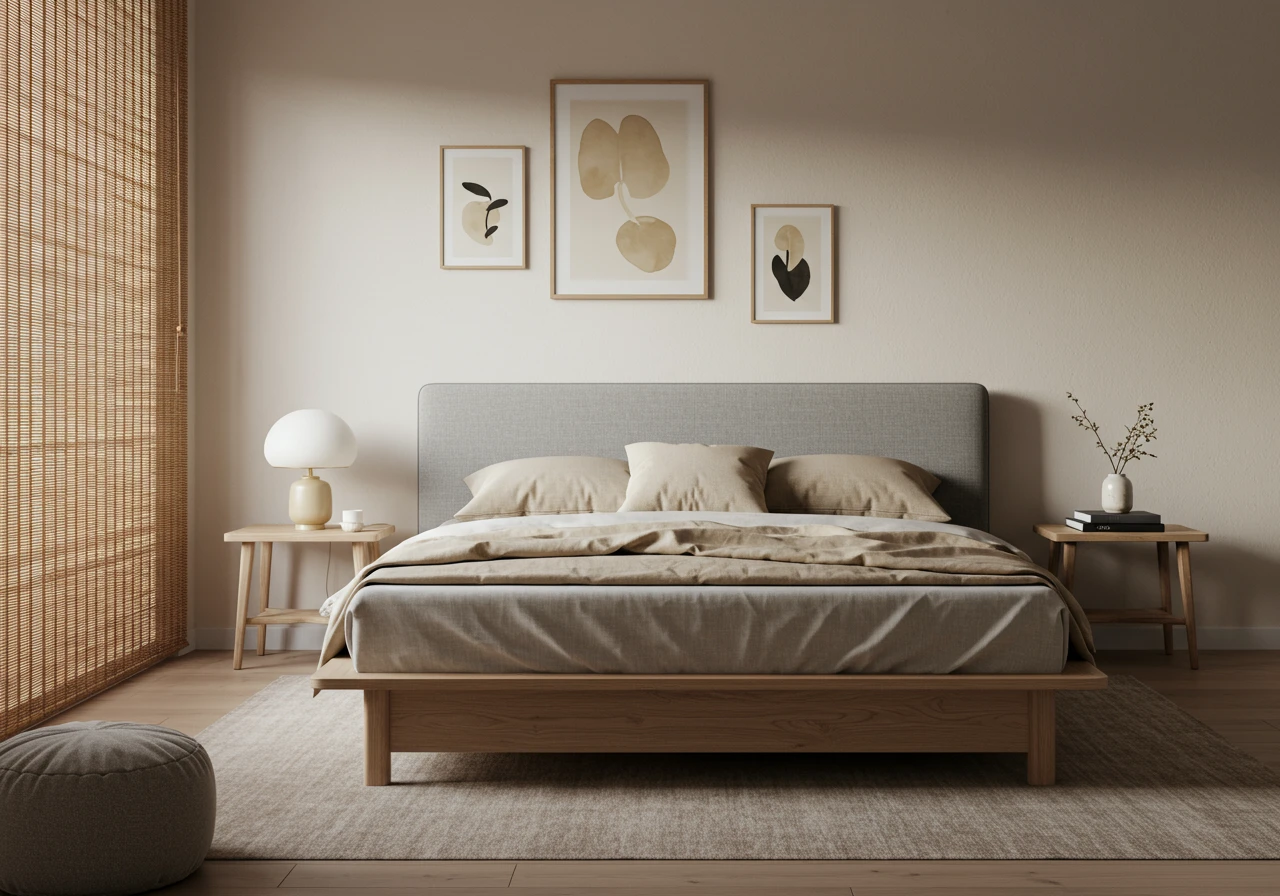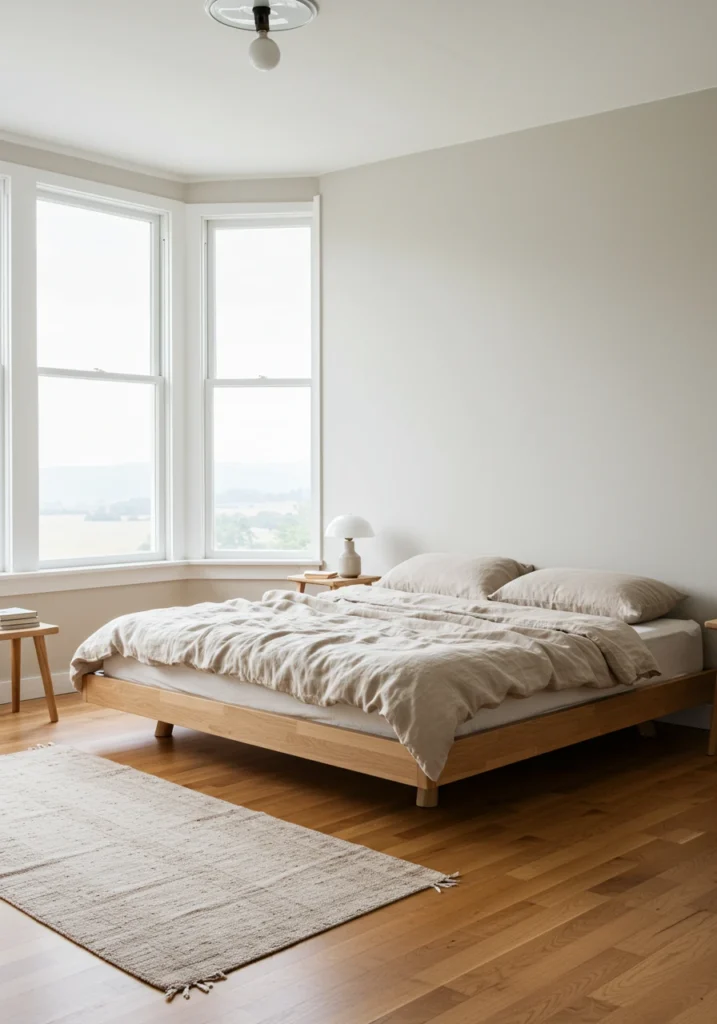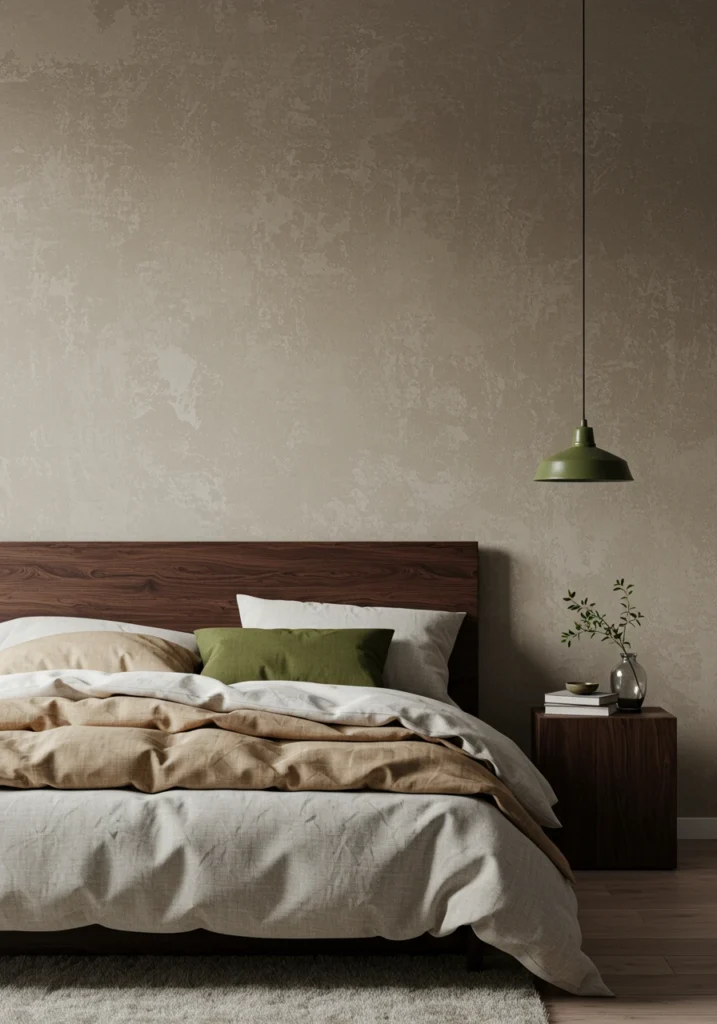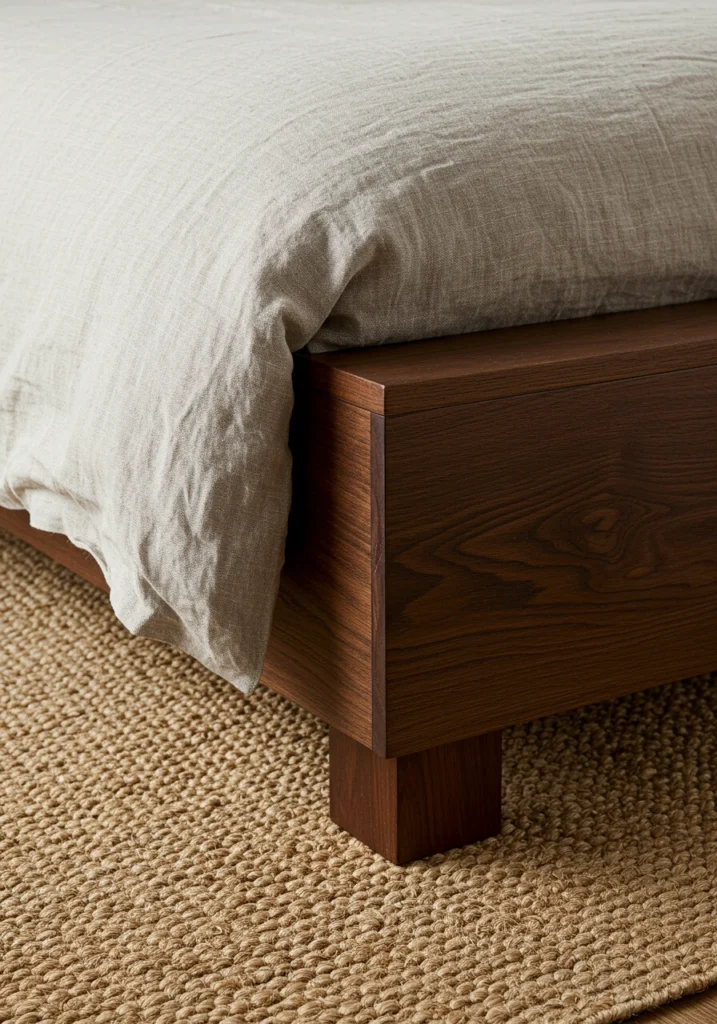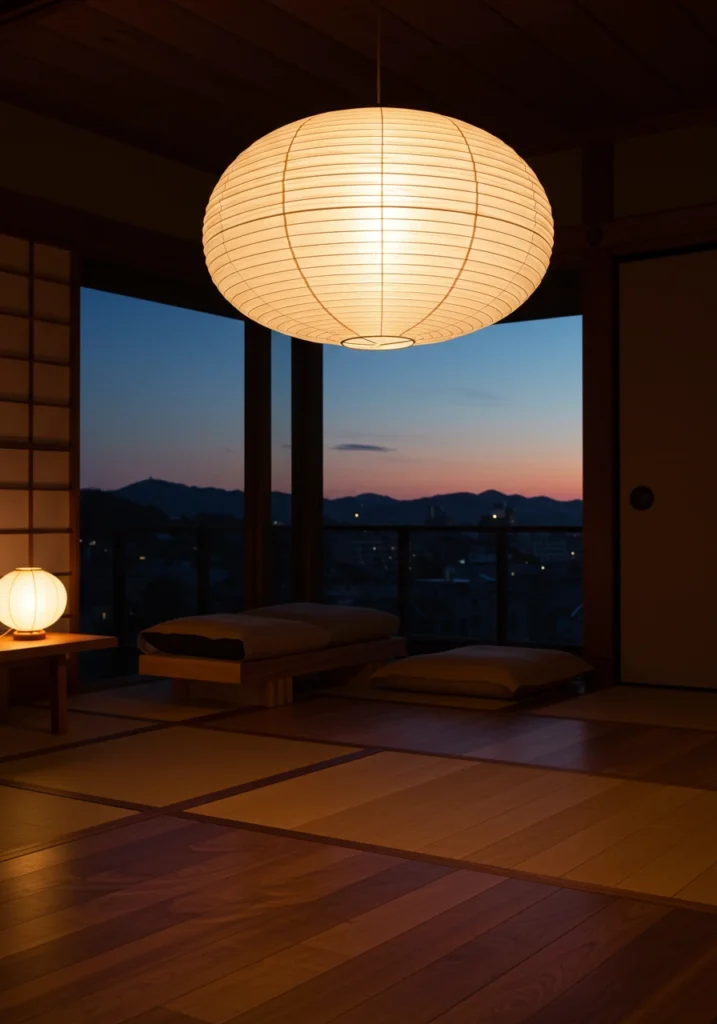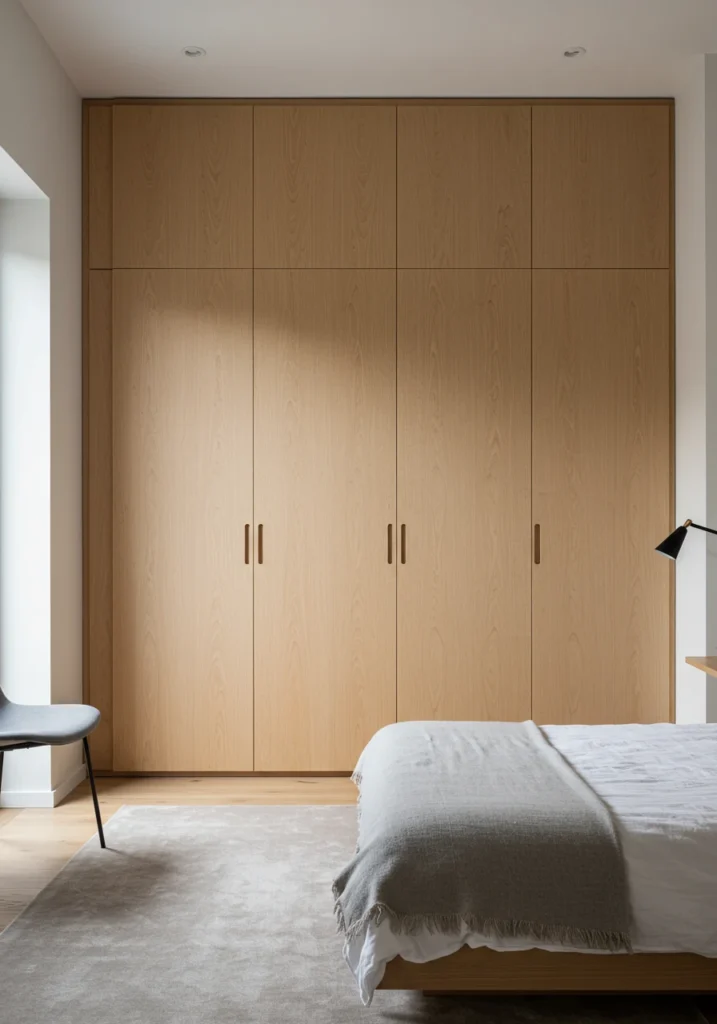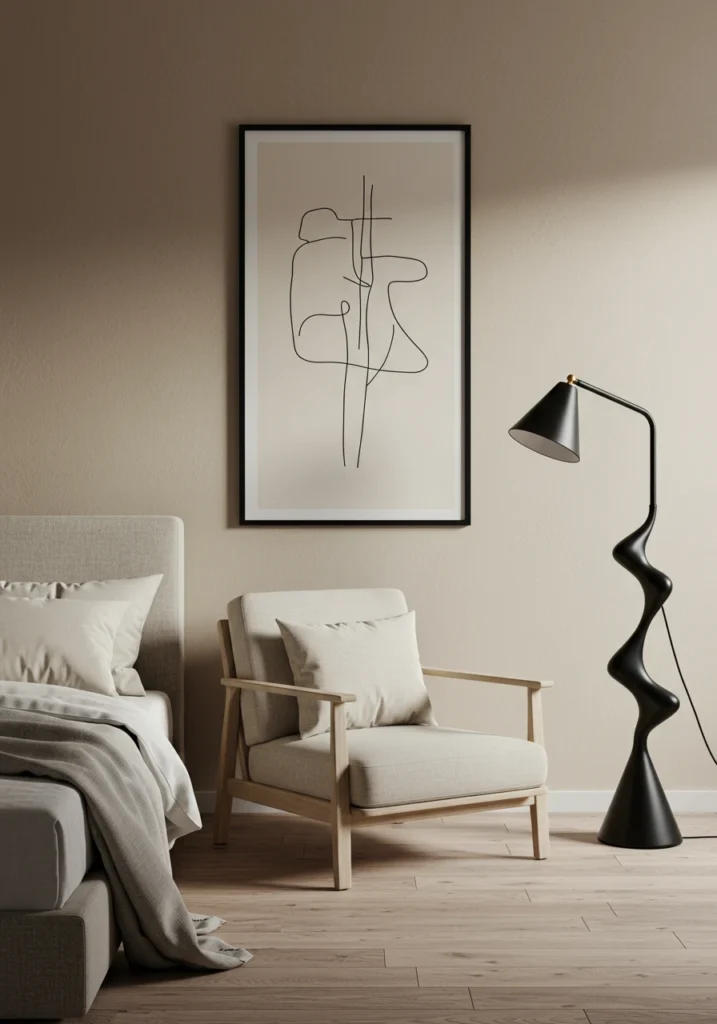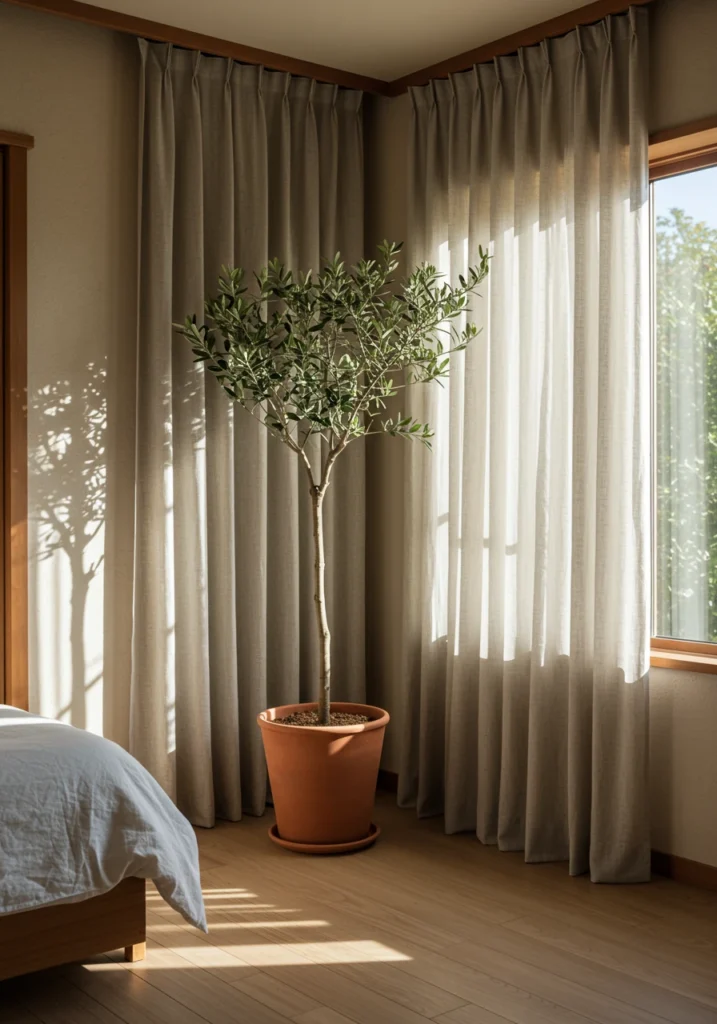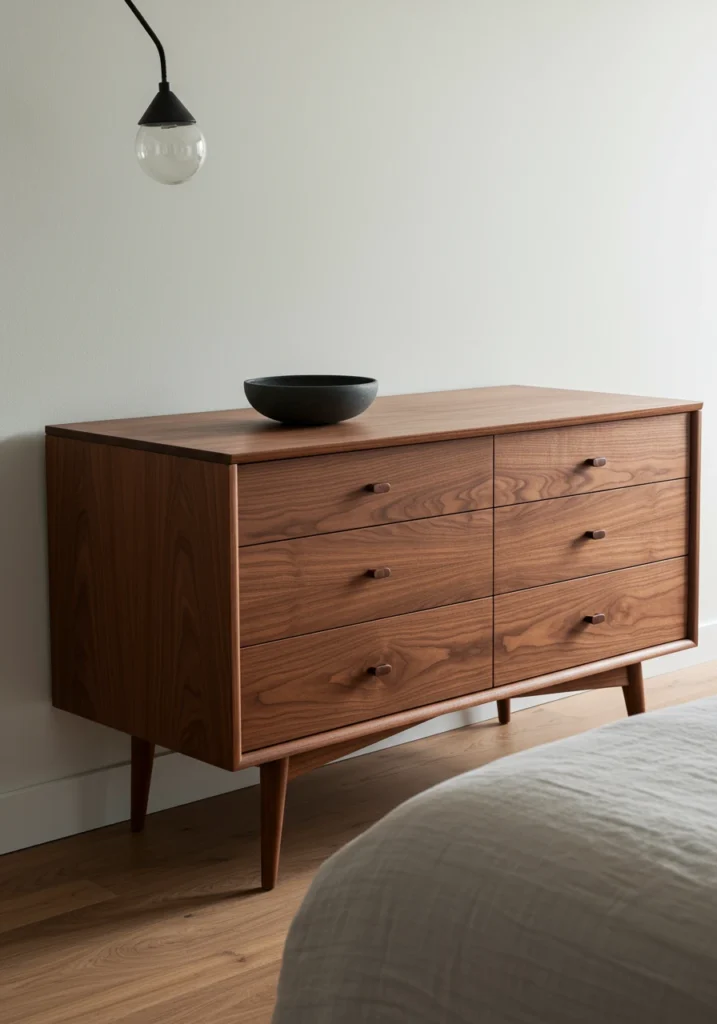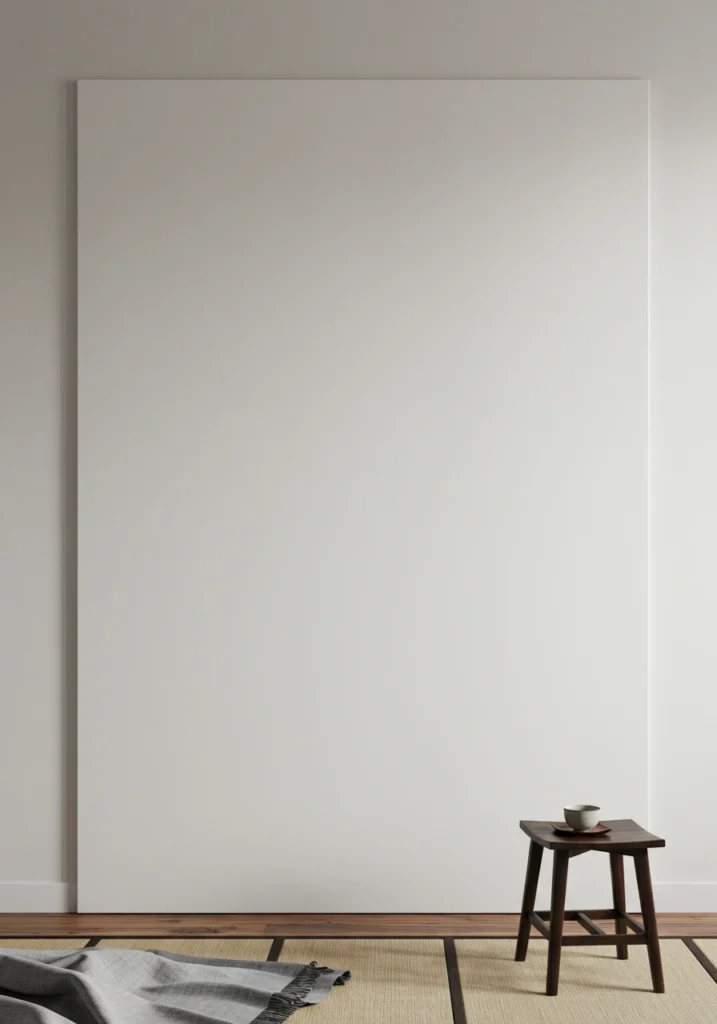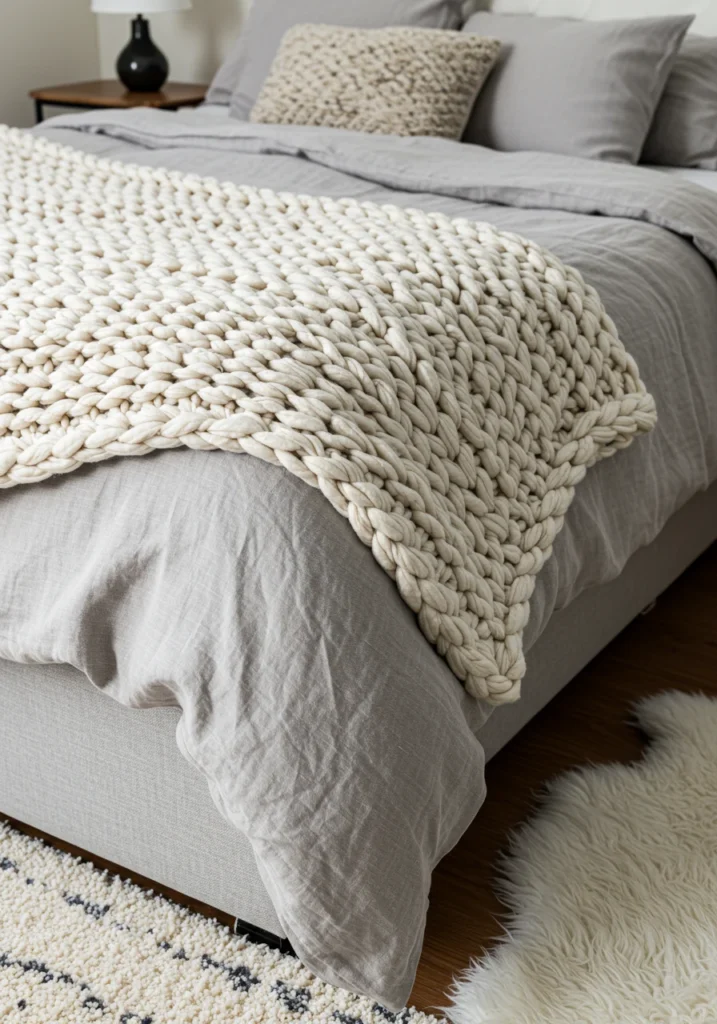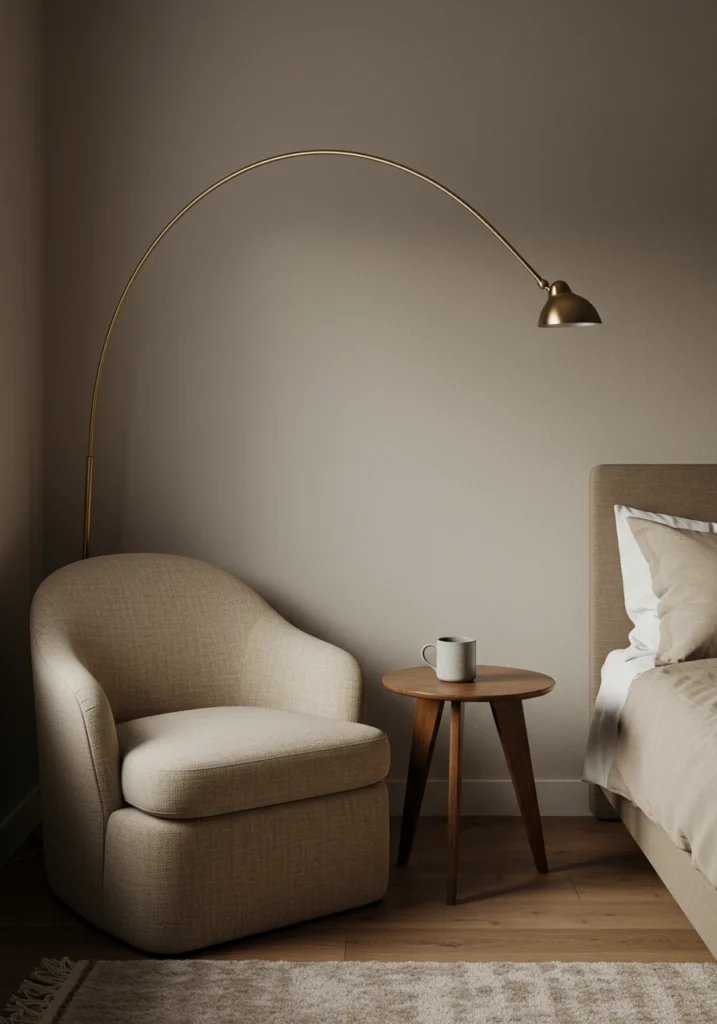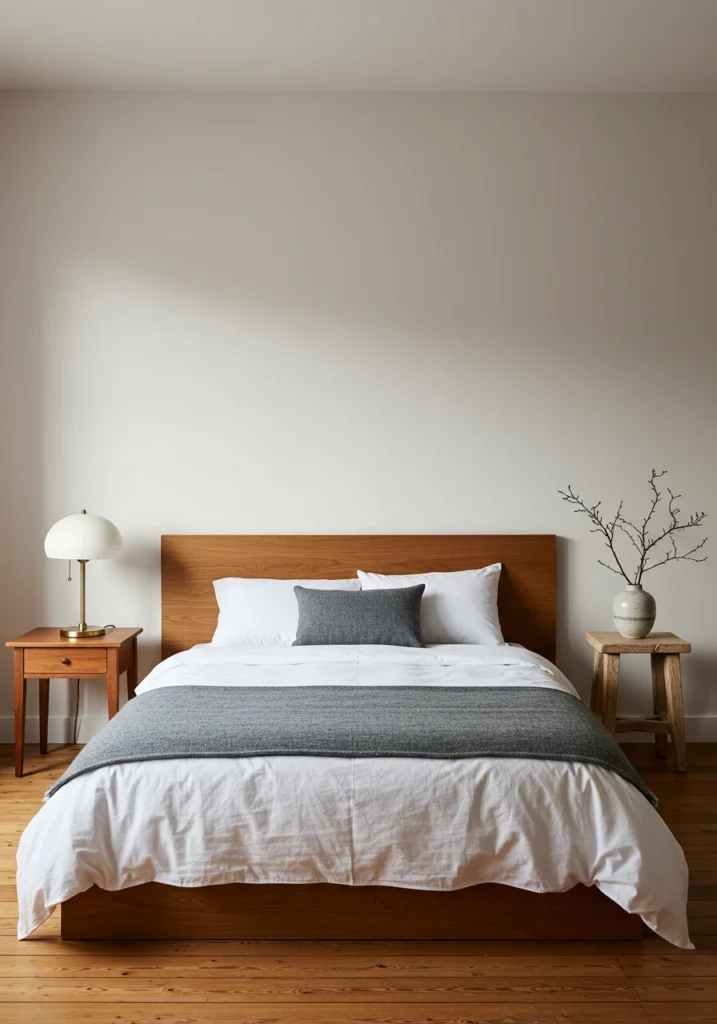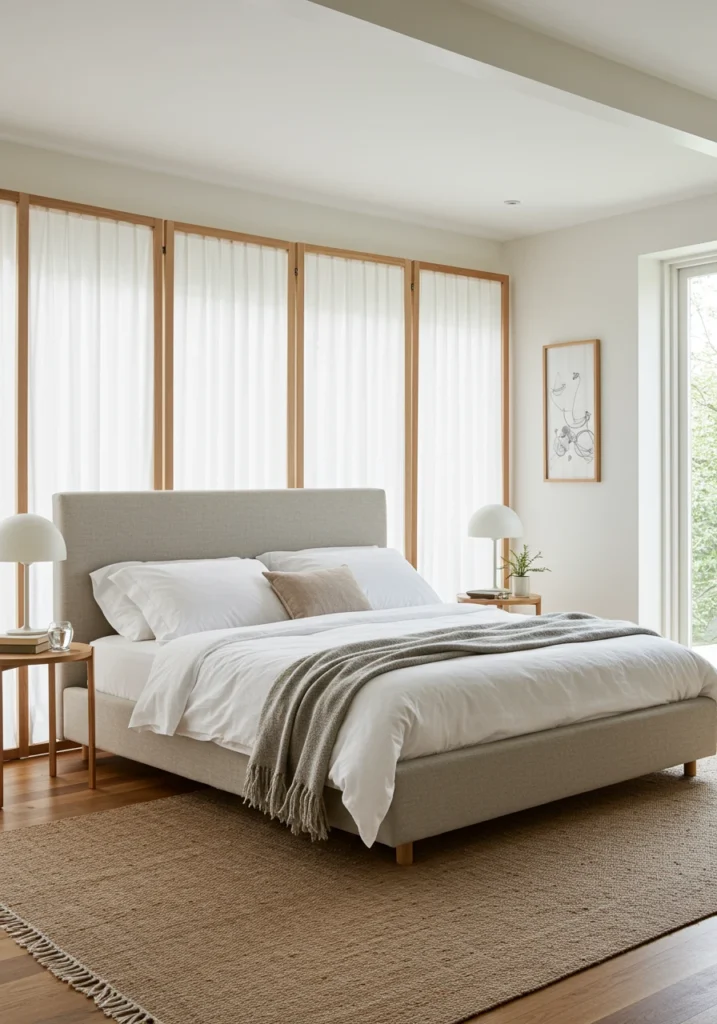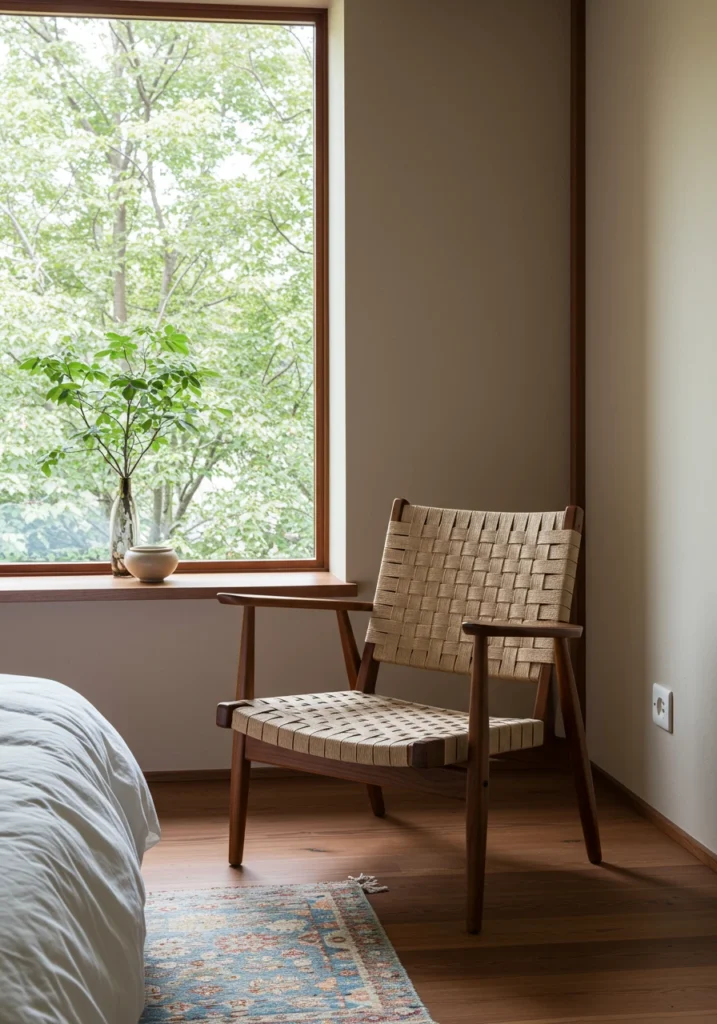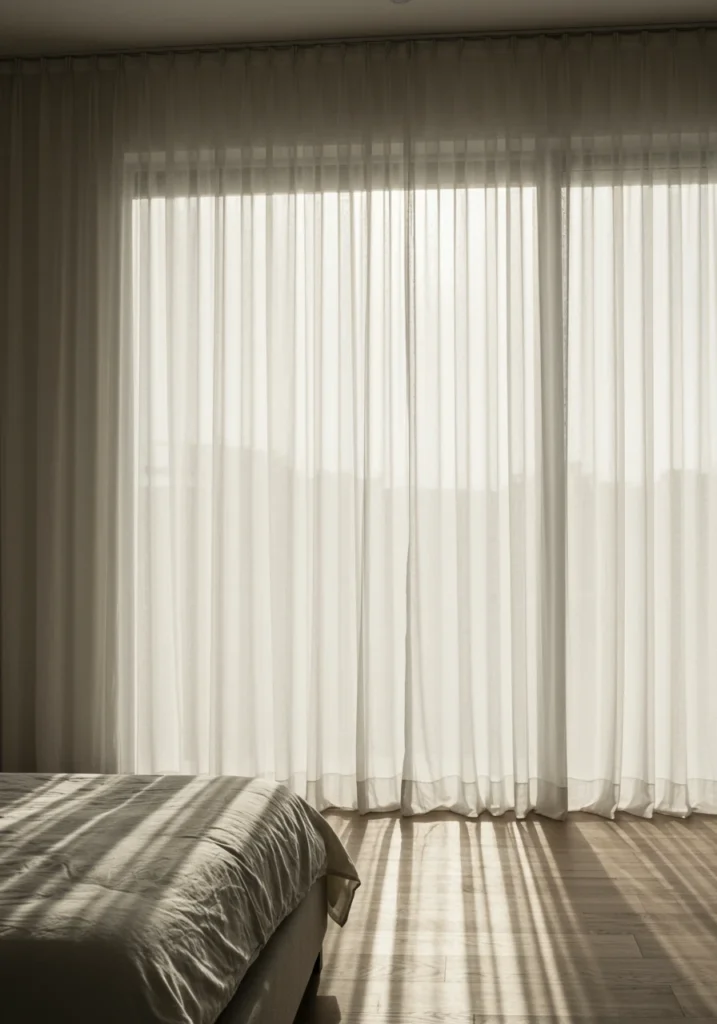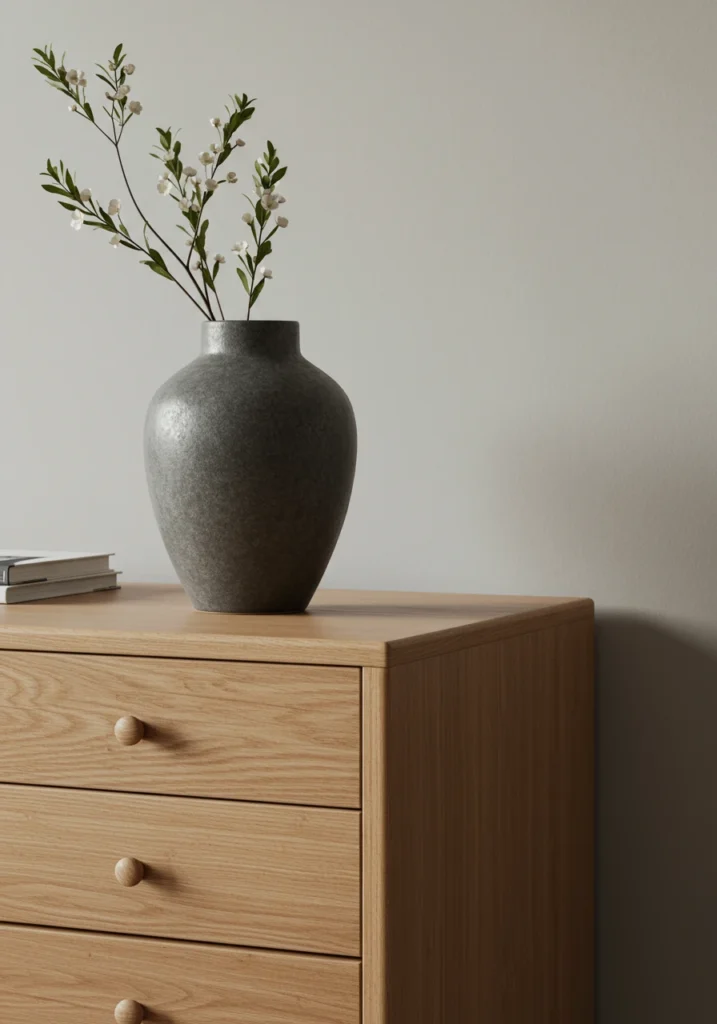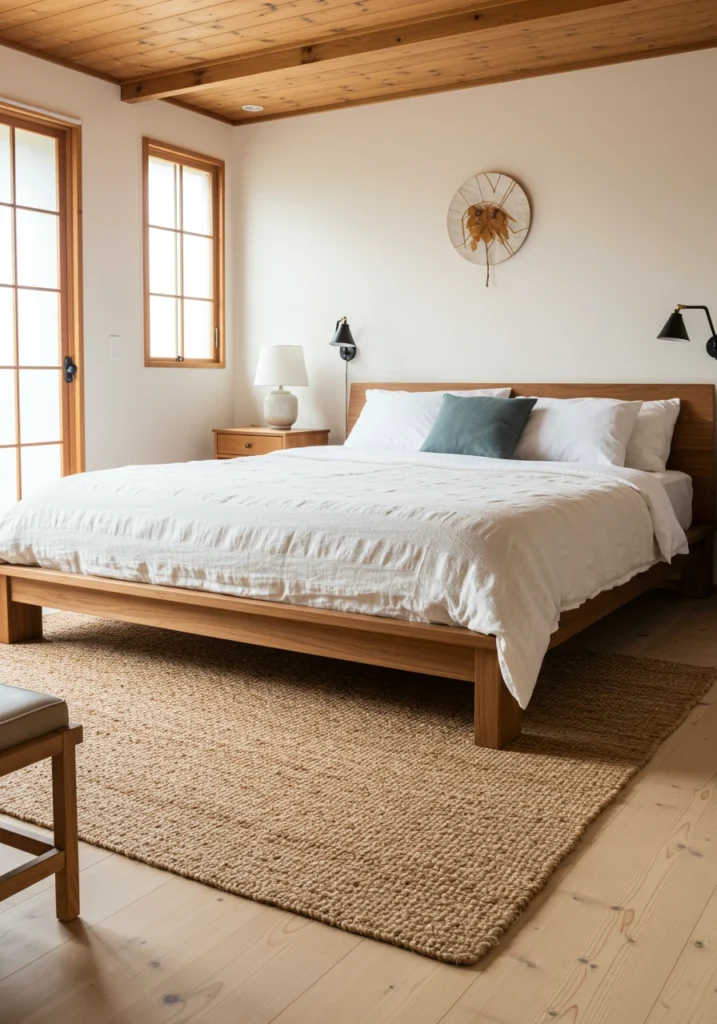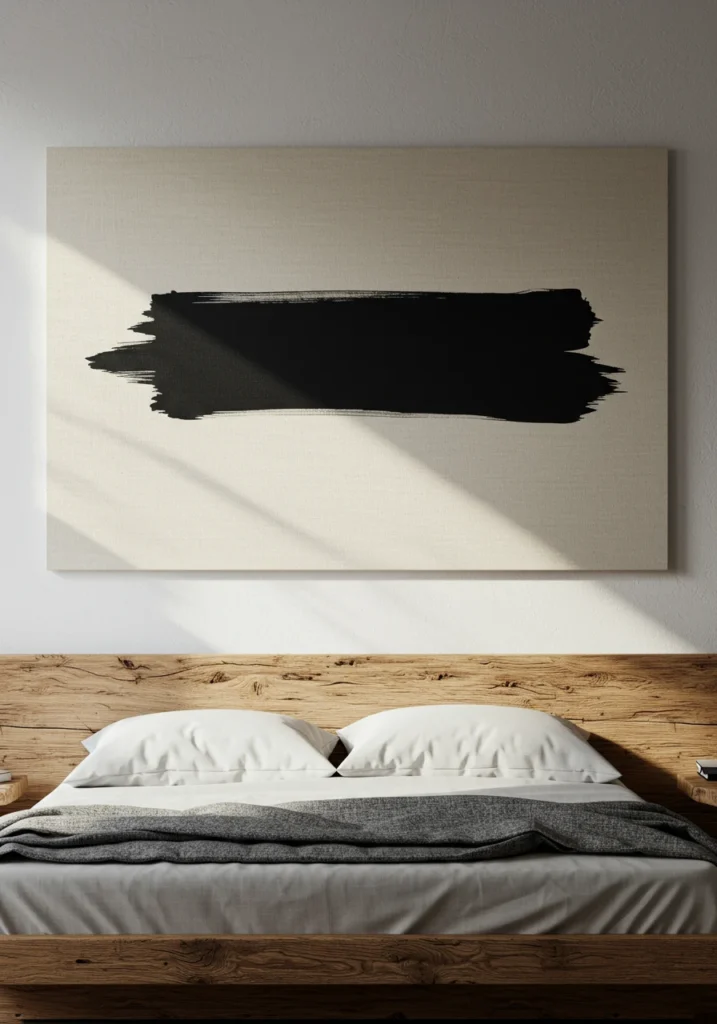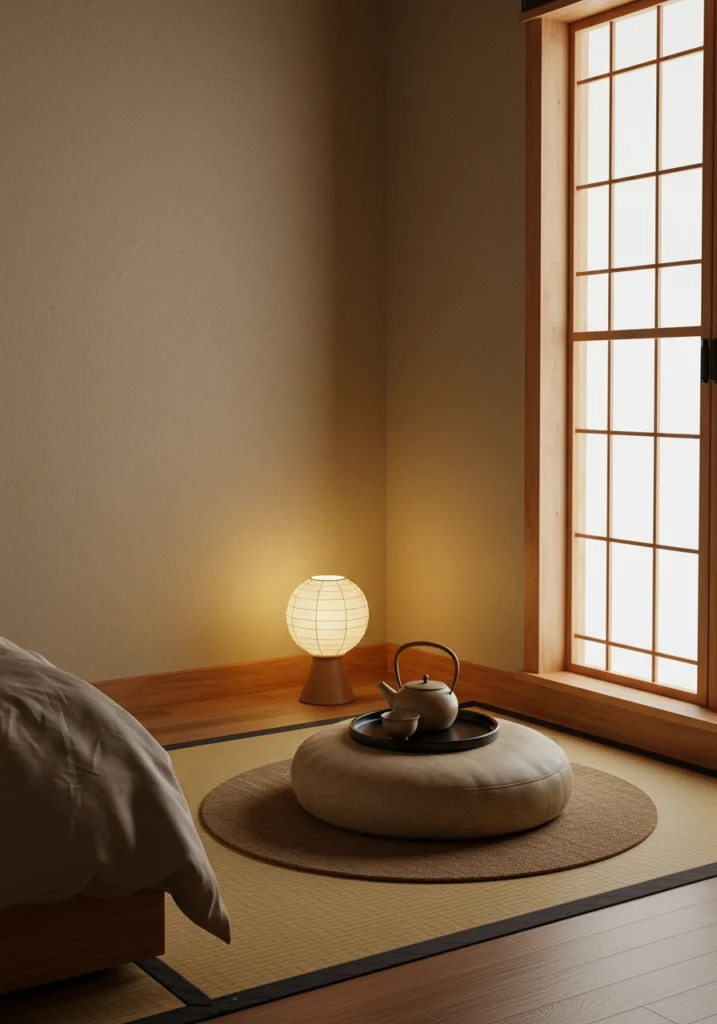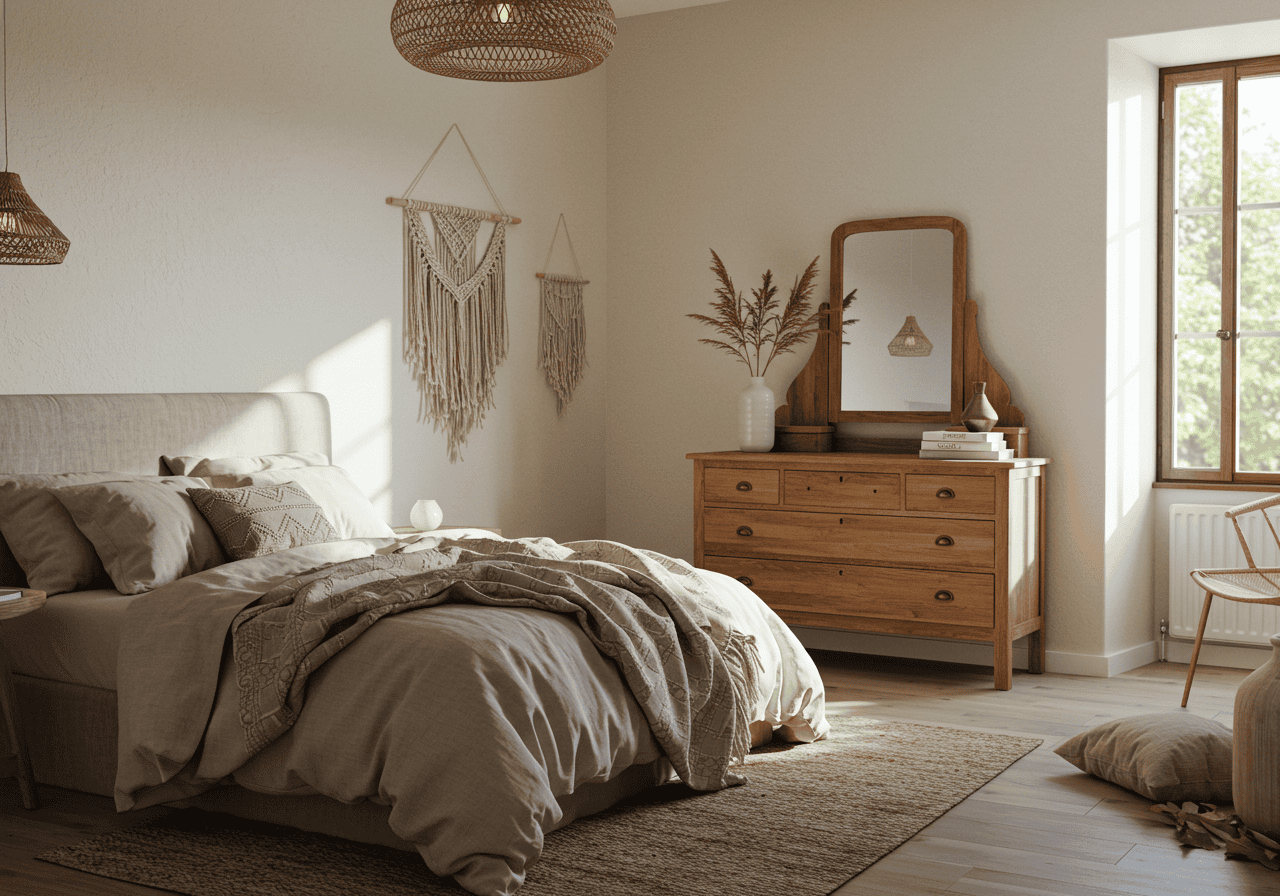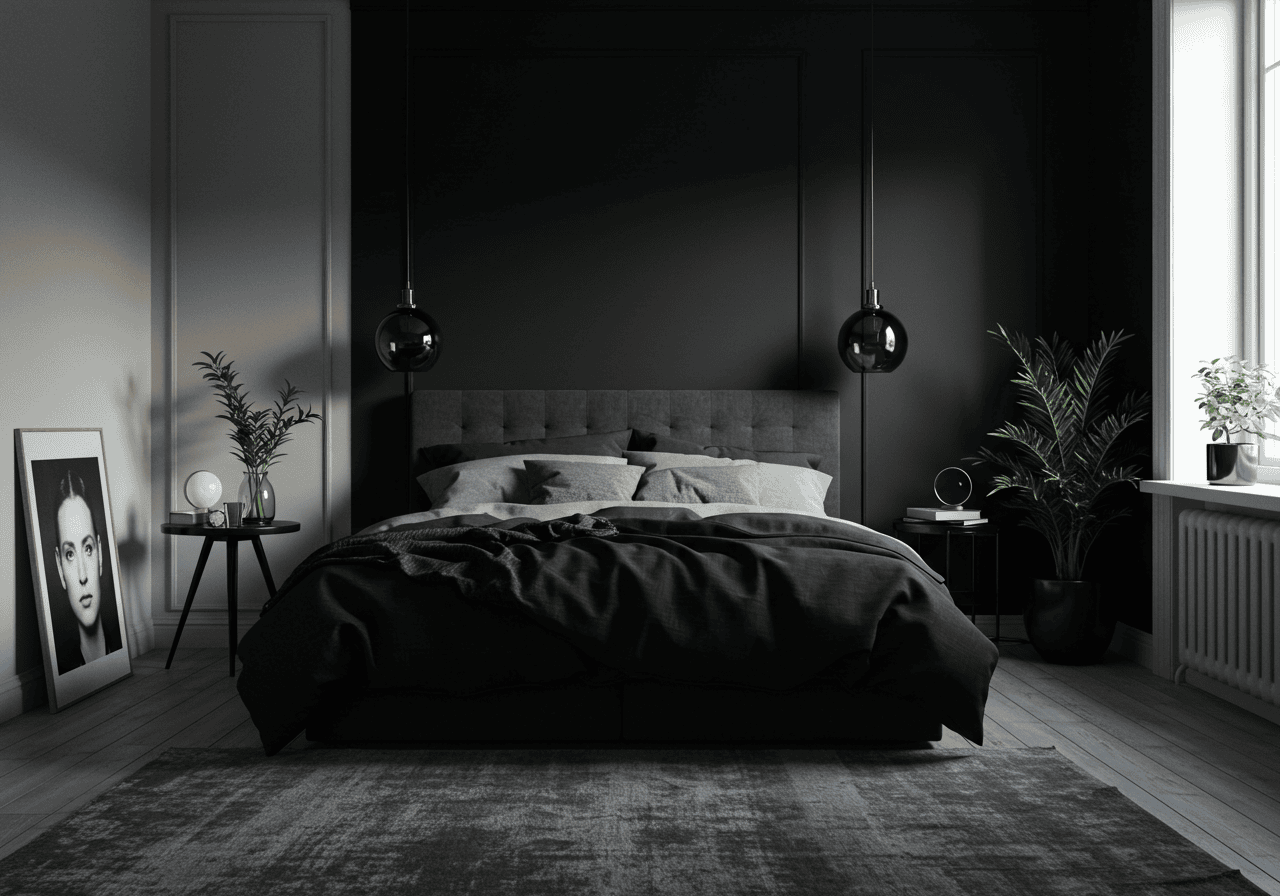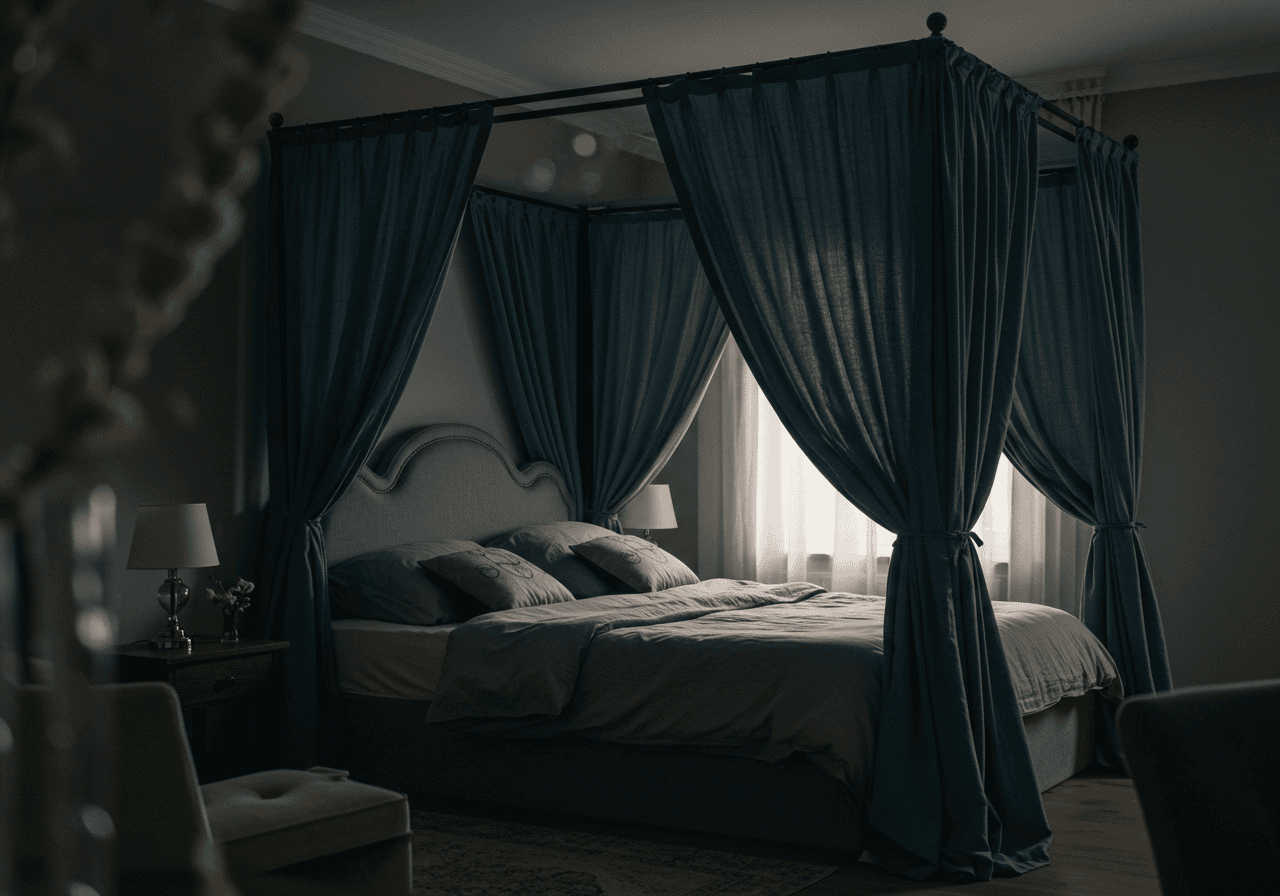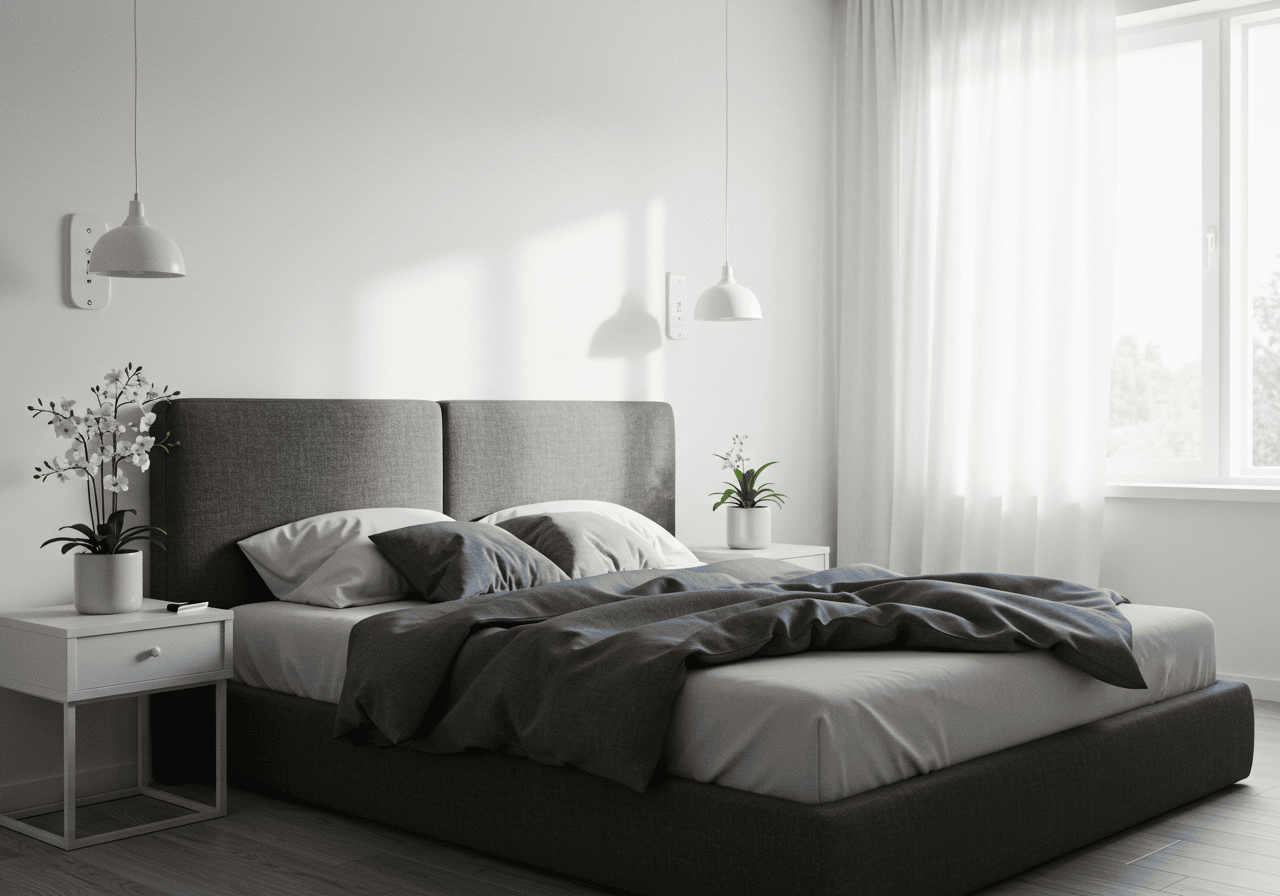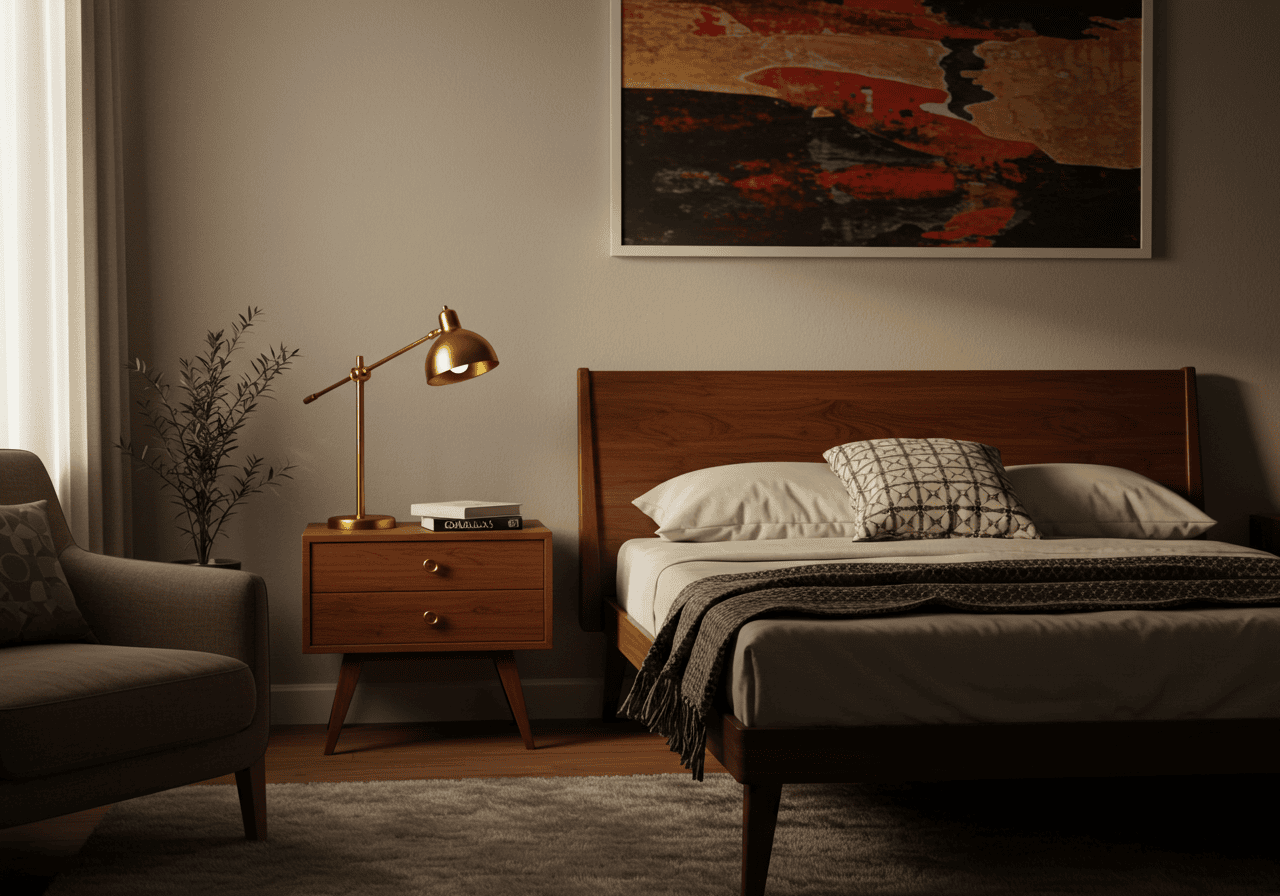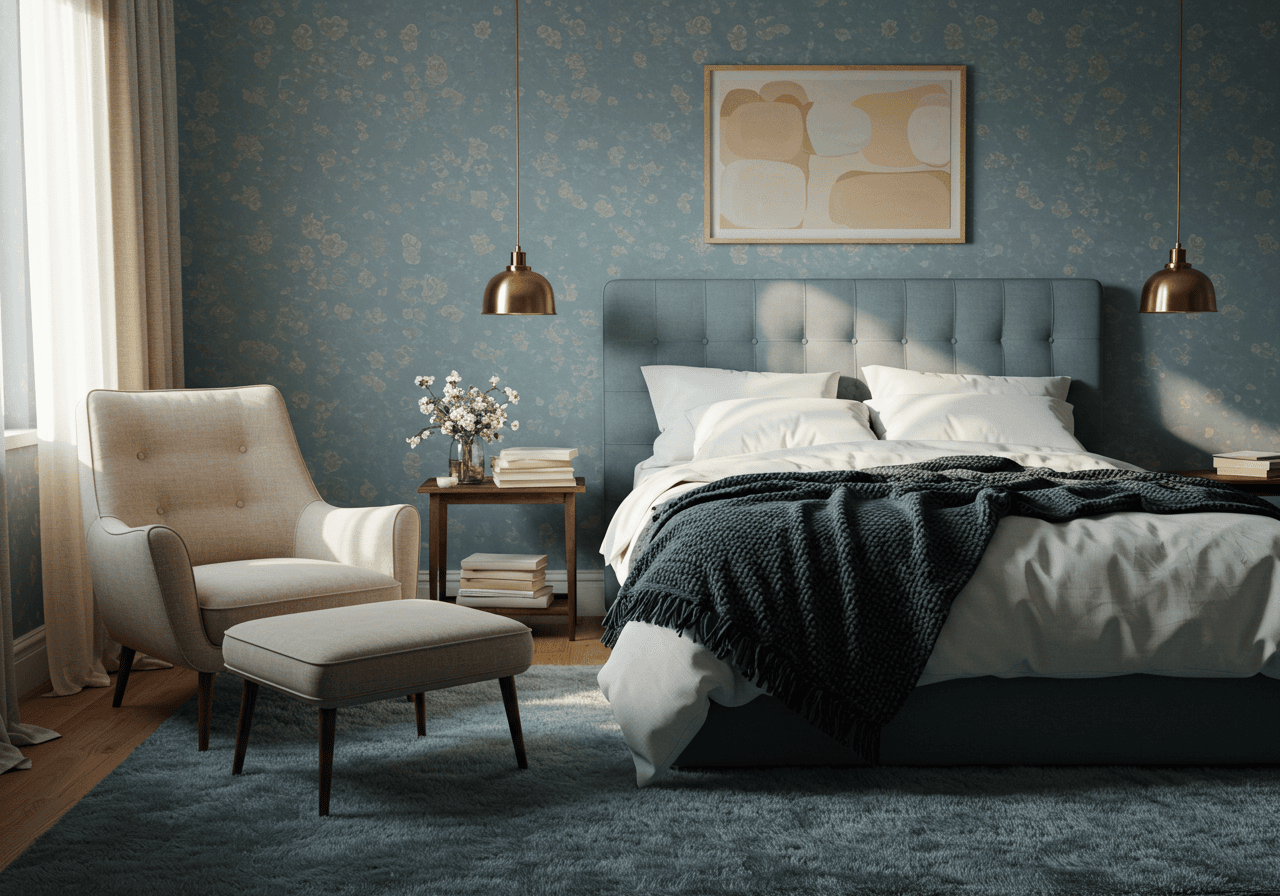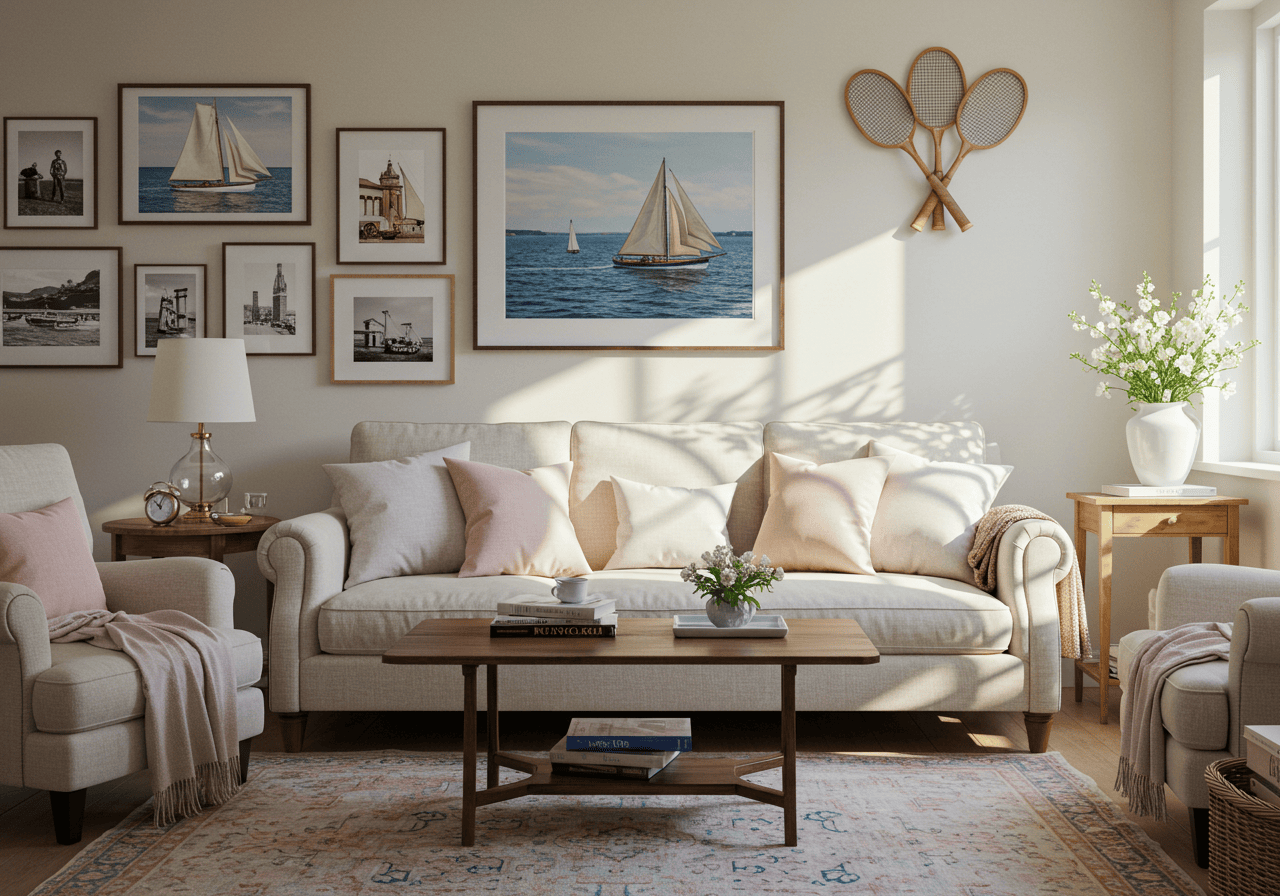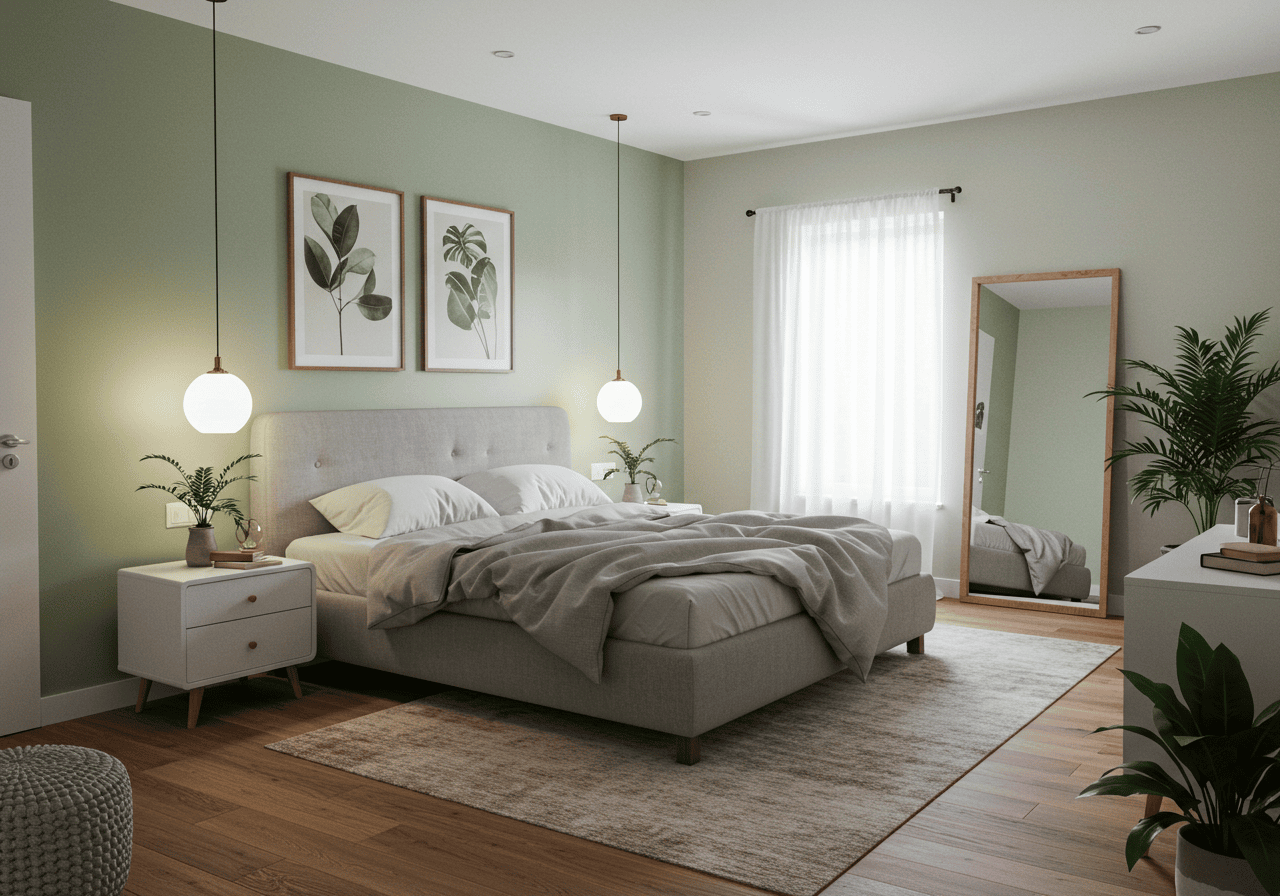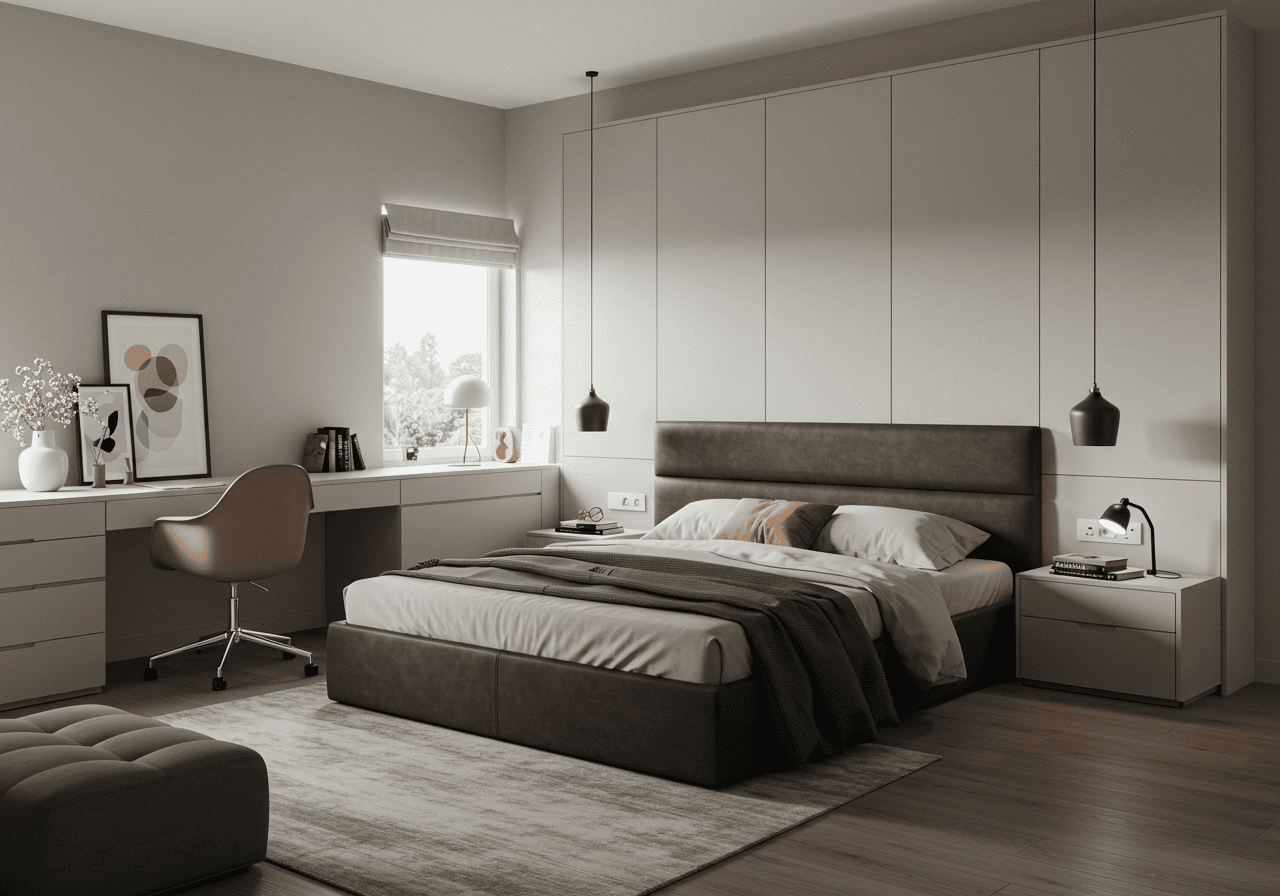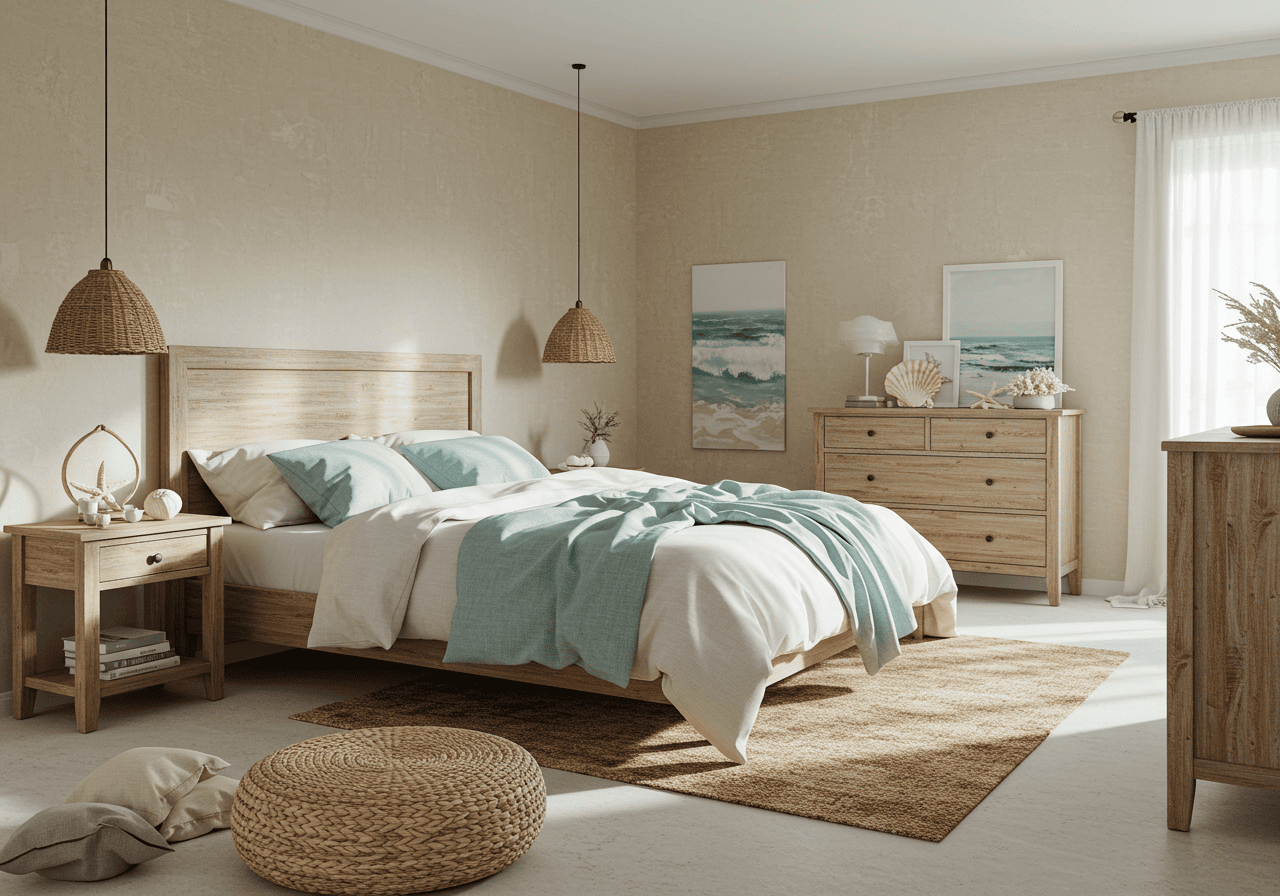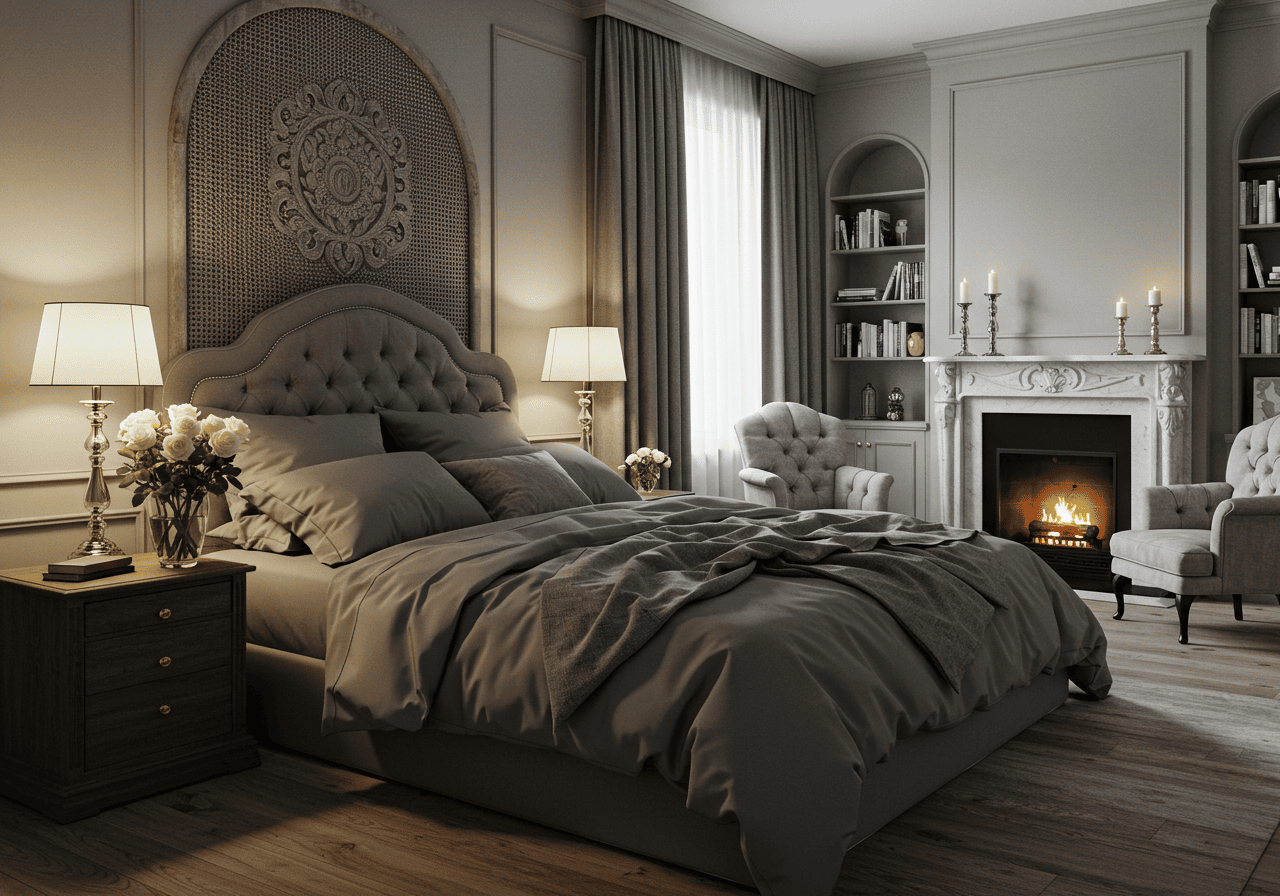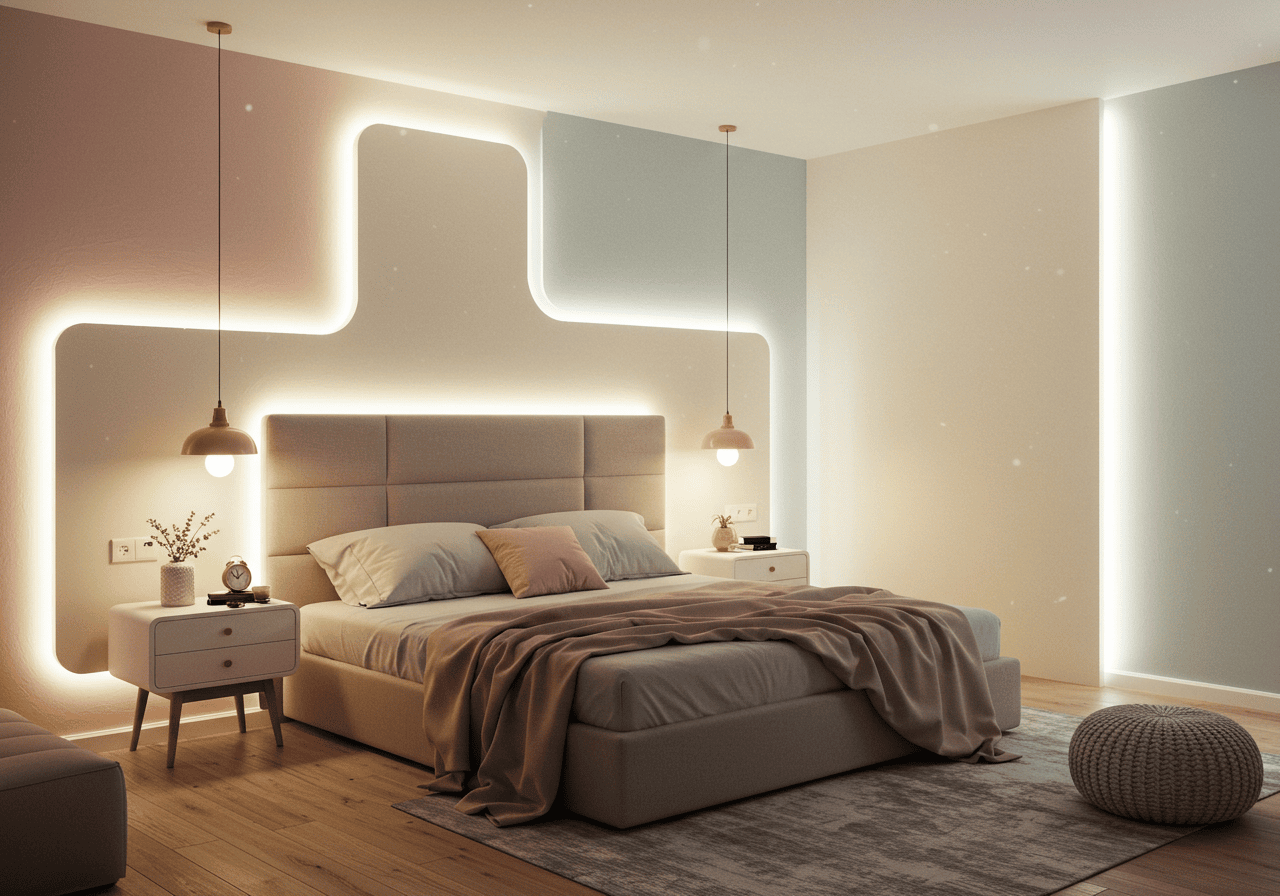Tired of the clutter? Craving a space that feels like a deep, calming breath at the end of a long day? Welcome to the world of Japandi. This isn’t just a design trend; it’s a philosophy. It’s the beautiful love child of Scandinavian hygge (that cozy, contented feeling) and Japanese wabi-sabi (the art of finding beauty in imperfection).
A Japandi bedroom is your personal retreat, a serene sanctuary that blends minimalist principles with organic warmth. It’s all about clean lines, natural materials, and a deep appreciation for craftsmanship and functionality. Forget loud colors and busy patterns. Here, we celebrate uncluttered spaces, muted earth tones, and pieces that are as beautiful as they are practical.
Ready to transform your bedroom into a tranquil haven? Let’s explore 21 gorgeous and achievable Japandi bedroom ideas that will inspire you to embrace simplicity and style.
1. Embrace Grounded Living with a Low-Profile Bed
The heart of any bedroom is the bed, and in Japandi design, it’s all about feeling connected and grounded. A low-profile platform bed is a cornerstone of this style, echoing the traditional Japanese futon while offering modern Scandinavian comfort.
This design choice works wonders for a room’s atmosphere. By sitting closer to the floor, the bed creates an illusion of higher ceilings and a more open, airy space. It’s a simple switch that instantly makes your room feel more spacious and serene.
- Expert Tip: Choose a bed frame made from light-colored wood like oak or maple for a classic Scandi feel, or a darker walnut or black-stained wood for a touch of Japanese elegance. Dress it with simple, high-quality linens in solid, neutral colors like oatmeal or soft gray.
- Why it works: This minimalist approach removes unnecessary bulk, promoting a sense of calm and aligning perfectly with the core tenets of minimalist bedroom ideas.
2. Master the Art of the Neutral, Earthy Palette
Color is everything when it comes to setting a mood. The Japandi palette is your secret weapon for creating an instantly calming environment. It moves beyond the stark whites of pure Scandinavian design and embraces a warmer, more nuanced range of neutrals inspired by nature.
Think of the colors of a peaceful landscape:
- Warm beige and oatmeal
- Soft stone gray
- Earthy mushroom and taupe
- Deep charcoal and ink black for contrast
- Muted greens like sage and olive
These colors are grounding and sophisticated. They create a perfect backdrop for the natural textures and materials that are so central to the Japandi style, allowing each element in the room to shine without competing for attention. If you love these soothing tones, you’ll find even more inspiration in these beige bedroom ideas.
3. Celebrate Imperfection with Natural Textures
Japandi design is a feast for the senses, especially touch. It’s about creating depth and interest not through color, but through a rich tapestry of natural, organic textures. This is where the Japanese concept of wabi-sabi truly comes to life—finding beauty in the raw, imperfect, and natural.
Combine different materials to create a space that feels curated yet completely effortless.
- Wood: Unfinished or lightly stained wood brings warmth and character. Look for pieces with a visible grain.
- Linens: Choose slubby, textured linen for your bedding and curtains. It’s breathable, beautiful, and gets better with age.
- Rattan & Bamboo: A woven rattan light fixture, a bamboo screen, or a jute rug adds a layer of handcrafted artistry.
- Ceramics: Place a matte, unglazed ceramic vase with a single dry branch on your dresser for a simple, sculptural moment.
This blend of textures is the key to making a minimalist space feel warm and inviting, a hallmark of the organic modern bedroom style.
4. Set a Serene Mood with Soft, Sculptural Lighting
Forget harsh, overhead lighting. In a Japandi bedroom, lighting is an art form used to create a soft, warm, and intimate glow. The goal is to layer different light sources to build a gentle ambiance that can be adjusted throughout the day.
Statement pieces are often inspired by nature and Japanese craftsmanship. Paper lanterns, particularly those inspired by Isamu Noguchi’s Akari light sculptures, are a perfect choice. Their delicate, lightweight forms diffuse light beautifully, casting a warm, moon-like glow that feels incredibly tranquil.
- Expert Tip: Opt for warm-toned, dimmable LED bulbs. This allows you to control the intensity of the light, transitioning from a brighter, functional light for reading to a soft, ambient glow for winding down in the evening. Explore how modern LED lighting for the bedroom can be both beautiful and functional.
- Key elements: Look for fixtures made of natural materials like paper, wood, rattan, or linen. A low-hanging woven pendant or a simple, sculptural table lamp can serve as a functional piece of art.
5. Prioritize Purposeful, Concealed Storage
The Japandi philosophy is built on the principle of “less is more.” This means decluttering isn’t a chore; it’s an essential part of creating a peaceful mind and a peaceful room. The secret? Smart, seamless, and often hidden storage solutions that keep your essentials accessible but out of sight.
Think sleek, handle-less wardrobes that blend into the wall, a platform bed with built-in drawers, or a simple wooden bench at the foot of the bed that doubles as a storage chest. Every piece should serve a function, eliminating the need for purely decorative furniture that just collects dust.
- Expert Tip: Before buying storage, take inventory of what you need to store. This ensures you choose solutions that are perfectly suited to your needs, preventing future clutter. This intentional approach is a game-changer, especially for creating functional and beautiful bedroom ideas for small rooms.
6. Ground the Space with Bold Black Accents
While the Japandi palette is predominantly soft and neutral, it thrives on contrast. A touch of black is the perfect way to add depth, drama, and a sophisticated edge to your serene space. This technique, known as ‘shibui’ in Japanese aesthetics, is about finding the balance between simplicity and complexity.
You don’t need to go all out. A little goes a long way:
- A slim, black metal bed frame
- A black-stained wooden bench
- A matte black ceramic vase
- A minimalist black floor lamp
- Window frames painted a deep charcoal black
These dark elements act as anchors, grounding the lighter tones in the room and making the entire design feel more intentional and defined. It’s a bold move that elevates the style, creating a look that is both calming and confident, much like the stunning spaces found in these black bedroom designs.
7. Invite Nature In with Biophilic Elements
A core principle of both Japanese and Scandinavian design is a deep reverence for nature. Bringing the outdoors in—a concept known as biophilic design—is essential for creating a true Japandi sanctuary. This is more than just adding a plant; it’s about mindfully incorporating natural elements that soothe the soul.
A single, elegant Fiddle Leaf Fig or a delicate bonsai tree can act as a living sculpture. A vase holding a few gracefully arching branches of pampas grass or eucalyptus adds texture and a subtle, natural fragrance. These elements purify the air and connect your space to the calming rhythms of the natural world, a practice central to a harmonious Feng Shui bedroom.
8. Opt for Function as Art
In a Japandi bedroom, there’s no room for clutter or meaningless trinkets. Instead, everyday objects and furniture are chosen for their inherent beauty and craftsmanship. Let a single, exquisitely designed piece become the functional art and focal point of your room.
This could be a beautifully crafted wooden dresser with clean lines and unique joinery, an iconic Scandinavian armchair with a sculptural form, or a hand-thrown ceramic lamp. By investing in one or two high-quality, statement pieces, you create a sense of quiet luxury and intentionality. The rest of the room can remain simple, allowing these special items to truly shine. This focus on form and function is a key element of many modern bedroom designs.
9. Embrace ‘Ma’: The Art of Negative Space
One of the most powerful—and often overlooked—elements of Japanese design is the concept of ‘Ma’ (間). This refers to negative space—the empty, unadorned areas on walls, floors, and surfaces. It’s the pause in the music that makes the notes beautiful.
Resist the urge to fill every corner and cover every wall. Let your beautiful furniture and decor pieces breathe.
- Leave a wall completely blank to draw attention to the texture of the paint.
- Allow for ample open floor space around your bed and furniture.
- Keep surfaces, like nightstands and dressers, almost entirely clear.
This intentional emptiness creates a sense of calm, clarity, and sophistication. It allows the eye to rest and appreciate the beauty of each individual object in the room. A great way to start is by creating a serene canvas, as seen in many white bedroom ideas, and then carefully curating what you add.
10. Layer Up for a Touch of ‘Hygge’
Here’s where the cozy heart of Scandinavia comes into play. While the overall look is minimal, a Japandi bedroom should never feel cold or sterile. The Danish concept of ‘hygge’ is all about creating a feeling of cozy contentment, and the best way to do that is through layering soft, inviting textiles.
Drape a chunky knit wool throw over the end of your bed. Place a soft, high-pile sheepskin rug next to your bed so it’s the first thing your feet touch in the morning. Mix and match linen and cotton bedding in complementary neutral tones. These layers add warmth, comfort, and tactile interest, making your minimalist sanctuary a place you’ll want to curl up and stay in. It’s the perfect way to bring your cozy bedroom ideas to life within a minimalist framework.
11. Choose Wood with Character and Soul
Wood is the soul of Japandi design, linking the Scandinavian love for light woods with the Japanese appreciation for darker, richer tones. Don’t be afraid to mix them! The key is to choose pieces with visible grain, natural imperfections, and a sense of history.
This is where the wabi-sabi philosophy shines. A reclaimed wood bench, a nightstand with a live edge, or a headboard made from beautifully stained oak adds a layer of organic beauty that manufactured pieces simply can’t replicate. The textures and tones of natural wood bring warmth and a connection to the earth, giving your room a timeless, soulful quality that feels both grounding and elegant, echoing the charm of a rustic bedroom.
12. Carve Out a Tranquil Reading Nook
Your bedroom should be a multi-functional sanctuary for rest, and a dedicated space for quiet contemplation is a Japandi must-have. You don’t need a lot of room to create a peaceful reading nook; just a quiet corner will do.
Combine a comfortable but visually light armchair—perhaps one with a simple wood frame and canvas upholstery—with a small side table for your book and a cup of tea. Complete the vignette with a soft-glow floor lamp for focused, gentle light. This little zone becomes your personal retreat within a retreat, a place to disconnect from screens and reconnect with yourself. It’s a simple touch that can provide endless bedroom decoration inspiration.
13. Perfect the Art of Asymmetry
While harmony and balance are crucial in Japandi design, this doesn’t mean perfect symmetry. In fact, Japanese aesthetics often favor asymmetry to create a more dynamic and natural-feeling composition. Ditch the idea of perfectly matched bedside tables and lamps.
Try these balanced yet asymmetrical pairings:
- On one side of the bed, use a low, rectangular wooden stool. On the other, a taller, round pedestal table.
- Hang a single, low-hanging pendant light on one side, and place a small table lamp on the other.
- Balance a large piece of art on one wall with a grouping of smaller frames or a simple floating shelf on the opposing wall.
This thoughtful imbalance feels more organic and visually interesting, preventing the space from feeling too rigid or formal and adding to its unique aesthetic bedroom appeal.
14. Add Structure with Shoji-Inspired Screens
For a truly authentic touch, consider incorporating a folding screen. Inspired by traditional Japanese shoji screens, these versatile pieces are the ultimate blend of form and function. They can be used to divide a larger room, create a more intimate dressing area, or simply stand against a wall as a beautiful, textural art piece.
Look for screens made from light wood and rice paper (or a more durable fabric equivalent) to allow light to filter through gently. A darker, carved wooden screen can add a touch of drama and create a stunning focal point. It’s a brilliant solution for defining zones and adding privacy, making it one of the most elegant bedroom ideas for couples who share a multi-use space.
15. Channel Mid-Century Modern Silhouettes
There’s a natural and beautiful overlap between Japandi and Mid-Century Modern design. Both styles celebrate clean lines, organic forms, natural materials (especially wood), and the idea that furniture should be beautiful, uncluttered, and built to last.
Incorporating a few key Mid-Century Modern pieces is a seamless way to enhance your Japandi bedroom. Think of a dresser with iconic tapered legs, a sleek platform bed frame, or a wishbone-style chair in a corner. These timeless silhouettes blend perfectly with the minimalist aesthetic while adding a touch of classic, understated elegance. The fusion creates a space that feels both current and timeless, a hallmark of a great mid-century modern bedroom.
16. Keep Window Treatments Simple and Sheer
In a Japandi bedroom, natural light is a precious design element, not something to be blocked out. Heavy, ornate curtains have no place here. Instead, opt for window treatments that celebrate and diffuse sunlight, creating a soft, ethereal glow throughout the room.
Lightweight, sheer curtains made from natural fabrics like linen or cotton are the perfect choice. They provide a layer of privacy while still allowing the space to feel bright, airy, and connected to the outdoors. Choose them in a color that complements your wall paint, like a soft white, oatmeal, or light gray, to create a seamless, cohesive look. This approach enhances the overall tranquility, making even a tiny bedroom feel more spacious.
17. Elevate with Handcrafted Decor
The soul of Japandi lies in its appreciation for craftsmanship and authenticity. Move away from mass-produced, generic decor and instead, invest in a few special pieces that tell a story. This is about curating your space with items that have character and a human touch.
- A hand-thrown ceramic vase with subtle imperfections.
- A hand-carved wooden bowl for holding jewelry.
- A woven wall hanging made from natural fibers.
- A unique, sculptural object found at a local artisan market.
These items add a layer of warmth and personality that can’t be replicated. They celebrate the wabi-sabi principle of finding beauty in the imperfect and handmade, making your bedroom feel uniquely yours. This curated approach is central to creating truly aesthetic bedroom ideas.
18. Say Yes to a Low-Pile Rug
While wooden floors are a staple of Japandi design, a rug is essential for adding softness, defining the space, and providing a touch of cozy hygge underfoot. The key is to choose a rug that complements the room’s serene aesthetic rather than overwhelming it.
Opt for low-pile rugs made from natural fibers. Jute, sisal, and wool are all excellent choices that add subtle texture and warmth. Stick to the neutral color palette—think beige, cream, soft gray, or charcoal. If you do choose a pattern, make it minimal and geometric, like simple lines or a subtle abstract design, to maintain the room’s uncluttered and calming vibe.
19. Use Art Sparingly but Intentionally
Just like with decor, the Japandi approach to art is “quality over quantity.” A gallery wall packed with prints would feel too busy and chaotic here. Instead, select one or two pieces of art that truly resonate with you and give them the space to make an impact.
Consider a large, abstract painting with simple brushstrokes and a muted color palette. A piece of minimalist line art or a traditional Japanese ink wash (sumi-e) painting can also be a stunning choice. The goal is to choose art that evokes a sense of calm and complements the room’s tranquil atmosphere without demanding all the attention. Remember the concept of ‘Ma’—the empty wall space around the art is just as important as the art itself.
20. Integrate a Moment of Muted Green
While the Japandi palette is built on a foundation of warm neutrals, a gentle touch of color can bring the entire space to life. Muted, earthy green is the perfect accent color, as it deepens the connection to nature and adds a sophisticated yet calming feel.
Incorporate this hue in subtle, thoughtful ways:
- A single velvet cushion in a deep olive green.
- Bed linens in a soft, dusty sage.
- A piece of art that features shades of forest green.
- For the bold, a single accent wall painted in a rich, dark green bedroom shade can create a stunning, moody backdrop.
This subtle hint of color adds depth and personality without disrupting the room’s overall sense of peace and harmony.
21. Design a Space for Ritual
Ultimately, a Japandi bedroom is more than just a style—it’s a mindset. It’s about creating an environment that supports calm, mindfulness, and daily rituals. Think about how you want to feel in your space and design a small corner dedicated to a calming activity.
This could be a simple floor cushion and a low table for morning meditation or a tea ceremony. It might be a clear, uncluttered surface for journaling before bed. Or it could be a comfortable chair by the window for quiet reading. By intentionally designing a space for these rituals, you transform your bedroom from just a place to sleep into a true sanctuary for the mind, body, and soul, embracing the core principles of a Feng Shui bedroom.
Your Peaceful Retreat Awaits
Creating a Japandi bedroom is a journey in mindful design. It’s about stripping away the excess to reveal what is truly essential, beautiful, and functional. By blending the cozy comfort of Scandinavian hygge with the elegant simplicity of Japanese wabi-sabi, you can craft a personal sanctuary that feels both modern and timeless.
Remember to focus on natural materials, a soothing neutral palette, and pieces chosen with intention. More than just a trend, Japandi is a philosophy for a calmer, more beautiful way of living. Now, go on and create the serene escape you deserve!

